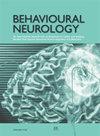使用 RU24969 在 BALB/c 小鼠中建立强迫症模型:最佳剂量选择的分子和行为研究
IF 2.3
4区 医学
Q2 CLINICAL NEUROLOGY
引用次数: 0
摘要
强迫症(OCD)是一种致残性疾病,以令人痛苦的强迫观念和重复性强迫行为为特征。强迫症的病因尚不清楚,而小鼠建模则有助于阐明这种疾病的遗传和神经化学基础,并研究潜在的治疗方法。本研究评估了 5-HT1B 激动剂 RU24969 对诱导雌性 BALB/c 小鼠()强迫症样行为的影响。行为评估包括大理石试验、悬挂尾巴试验、蔗糖偏好试验、强迫游泳试验和撕碎巢丸试验。此外,还对小鼠大脑中的Gabra1和5-羟色胺转运体进行了基因表达和蛋白质定量分析。高剂量 RU24969(15-20 毫克/千克)时,小鼠埋大理石的行为明显增加。与对照组相比,在相同的高浓度下,强迫游泳测试的数值也持续升高。蔗糖偏好测试表明,在 RU24969 剂量为 15 和 20 毫克/千克时,蔗糖偏好行为明显改变。雏鸟撕碎巢的结果在受试动物组间没有统计学意义。基因表达分析表明,随着 RU 剂量的增加,Gabra1 的表达量减少,而血清素转运体则与不同剂量的 RU24969 无关。Western 印迹证实了这些趋势。研究结果强调了血清素系统、GABA能信号传导和强迫症相关行为之间复杂的相互作用,并建议在BALB/c小鼠模型中使用腹腔注射15毫克/千克的RU24969来诱导强迫症样行为。本文章由计算机程序翻译,如有差异,请以英文原文为准。
Establishing an OCD Model in BALB/c Mice Using RU24969: A Molecular and Behavioural Study of Optimal Dose Selection
Obsessive-compulsive disorder (OCD) is a disabling disease characterized by distressing obsessions and repetitive compulsions. The etiology of OCD is poorly known, and mouse modeling allows to clarify the genetic and neurochemical basis of this disorder and to investigate potential treatments. This study evaluates the impact of the 5-HT1B agonist RU24969 on the induction of OCD-like behaviours in female BALB/c mice (), distributed across five groups receiving varying doses of RU24969. Behavioural assessments, including marble test, tail suspension test, sucrose preference test, forced swim test, and nestlet shredding test, were conducted. Gene expression and protein quantitation of Gabra1 and serotonin transporter in mouse brain were also performed. Marble-burying behaviour increased significantly at high doses of RU24969 (15-20 mg/kg). The forced swimming test consistently showed elevated values at the same high concentrations, compared to the control. Altered reward-seeking behaviour was indicated by the sucrose preference test, notably at 15 and 20 mg/kg doses of RU24969. Nestlet shredding results did not show statistical significance among the tested animal groups. Gene expression analysis revealed reduced Gabra1 expression with increasing doses of RU, while serotonin transporter was not related to varying doses of RU24969. Western blotting corroborated these trends. The results underscore complex interactions between the serotonin system, GABAergic signaling, and OCD-relevant behaviours and suggest the use of intraperitoneal injection of 15 mg/kg of RU24969 to induce OCD-like behaviour in BALB/c mouse models.
求助全文
通过发布文献求助,成功后即可免费获取论文全文。
去求助
来源期刊

Behavioural Neurology
医学-临床神经学
CiteScore
5.40
自引率
3.60%
发文量
52
审稿时长
>12 weeks
期刊介绍:
Behavioural Neurology is a peer-reviewed, Open Access journal which publishes original research articles, review articles and clinical studies based on various diseases and syndromes in behavioural neurology. The aim of the journal is to provide a platform for researchers and clinicians working in various fields of neurology including cognitive neuroscience, neuropsychology and neuropsychiatry.
Topics of interest include:
ADHD
Aphasia
Autism
Alzheimer’s Disease
Behavioural Disorders
Dementia
Epilepsy
Multiple Sclerosis
Parkinson’s Disease
Psychosis
Stroke
Traumatic brain injury.
 求助内容:
求助内容: 应助结果提醒方式:
应助结果提醒方式:


